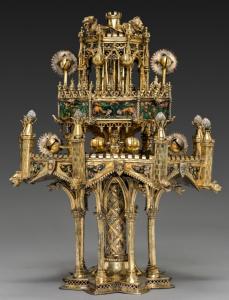Object Studies in Art History
Object Studies in Art History
In the field of art history, recent developments about images have shown how far horizons can broaden when the focus shifts beyond the traditional concept of art as defined in European modernity. If art history limits itself to visual studies, however, it drastically reduces its area of expertise, excluding from its scope entire categories of objects that are not images. European “decorative arts” especially of earlier periods spring to mind, but a wide variety of non-European artifacts, often originating in precolonial cultures, would also be disregarded. They should, on the contrary, have a decisive role in the field of art history, which is global in its relevance and can transcend boundaries between disciplines. Visual studies would benefit from being flanked by object studies, not to create opposition between the two areas, but rather so that they might enrich one another, not least because the complex relationship between images and objects is a central issue in our discipline.
Research on this topic is being led at DFK Paris by Philippe Cordez. Applications for grants and requests to join research projects are welcome for all periods and regions of study.
As introduction:
Philippe Cordez, Romana Kaske, Julia Saviello, and Susanne Thüringen, The Properties of Objects: Walt Disney’s Fantasia, in id. (eds.), Object Fantasies: Experience & Creation, Berlin/Boston: De Gruyter, 2018, pp. 7−17
Philippe Cordez, Object Studies in Art History: Research Perspectives, ibid., pp. 19−30
Some publications:
Philippe Cordez, Evelin Wetter, Die Krone der Hildegard von Bingen, Riggisberg: Abegg-Stiftung, 2019 (Monographien der Abegg-Stiftung, 21)
Philippe Cordez, Treasure, Memory, Nature: Church Objects in the Middle Ages, London / Turnhout: Harvey Miller Publishers, 2020
Ella Beaucamp and Philippe Cordez (eds.), Typical Venice? The Art of Commodities, 13th–16th Centuries, London / Turnhout: Harvey Miller Publishers, 2020 (In the Shadow of the Lion of St. Mark, 2)
Philippe Cordez and Julia Saviello (eds.), Fünfzig Objekte in Buchform. Vom Reliquiar zur Laptoptasche, Emsdetten: Imorde, 2020
Philippe Cordez and Ivan Foletti (eds. with the collaboration of Karolina Foletti): Objects Beyond the Senses. Studies in Honor of Herbert L. Kessler = Convivium. Exchanges and Interactions in the Arts of Medieval Europe, Byzantium, and the Mediterranean, VIII/1, 2021
Ongoing projects:
The Ivory Combs (5th–13th Centuries)
Approximately 100 ivory combs, mainly Western but also Byzantine and Islamic, have survived from the 5th to 13th centuries and will be for the first time comprehensively documented and published. The majority come from churches in Latin Christendom, while around 40 of them were considered as former possessions of historical persons. These narratives too will be systematically studied in the Corpuswerk, in connection with the moral interpretation of the combs and their use as insignia of power and as paraliturgical instruments. The volume will continue the series Die Elfenbeinskulpturen of the Deutsches Verein für Kunstwissenschaft.
Philippe Cordez, Golgotha im Kopf. Karl der Kahle und die karolingischen Elfenbeinkämme, in: Convivium. Exchanges and Interactions in the Arts of Medieval Europe, Byzantium, and the Mediterranean, VIII/1, 2021 (= Objects Beyond the Senses. Studies in Honor of Herbert L. Kessler, ed. by P. Cordez and I. Foletti with the collaboration of K. Foletti), pp. 102–131
The Cleveland Musical Fountain (Paris, ca. 1320)
The hydraulic and musical fountain in the Cleveland Museum of Art is a unique device of gilt and enamelled silver made in Paris ca. 1320. As exposed in a recent essay, a close comparison with the Fountain of Youth presented in text, image, and music in the Roman de Fauvel – a political satire recorded in a manuscript of 1317 (Bibliothèque nationale de France, ms. fr. 146) – suggests that the same group was involved in both creations. Indeed, the Cleveland fountain multisensorially evokes the Parisian royal palace as a divine Fountain of Youth rejuvenating the French Kingdom. The project in collaboration with Gerhard Lutz, Robert P. Bergman Curator of Medieval Art at the Cleveland Museum of Art, aims at deepening our knowledge of the fountain’s material constitution, festive performance, and historical context.
Philippe Cordez, Der Brunnen in Cleveland und der Pariser Königspalast (um 1320) / La fontaine de Cleveland et le palais royal à Paris (vers 1320), in: Jahresbericht. Deutsches Forum für Kunstgeschiche Paris / Rapport annuel. Centre allemand d’histoire de l’art Paris, 2019/2020, pp. 20–29
The DFK Paris contributed with a section on The City, the Senses, and the Arts. The Cleveland Musical Fountain and Multisensory Experience in 14th Century Paris to the 6th Forum Kunst des Mittelalters (Sinne / Senses, Frankfurt am Main, 28 Sept.–1st Oct. 2022)
Object Studies in Art History, a book series edited by Philippe Cordez and published by De Gruyter (Berlin/Boston)
1: Object Fantasies: Experience & Creation, ed. by Philippe Cordez, Romana Kaske, Julia Saviello, and Susanne Thürigen, 2018
2: Objekte des Krieges: Präsenz & Representation, ed. by Romana Kaske and Julia Saviello, 2019
3: Material Histories of Time: Objects and Practices, ed. by Gianenrico Bernasconi and Susanne Thürigen, 2020
– reviewed in: Artefact. Techniques, histoire et sciences humaines, 14, 2021, pp. 479–486 (L. Georges); Physis. International Journal for the History of Science, 57/1, 2022 (C. Zanetti)
4: Löwe, Wolfin, Greif. Monumentale Tierbronzen im Mittelalter, ed. by Joanna Olchawa, 2020
5: Objects & Organisms. Vivification, Reification, Transformation, ed. by Ella Beaucamp, Romana Kaske, and Thomas Moser, 2023
6: Susanne Thürigen, Turm, Spiegel, Buch. Astronomische Tischuhren in Süddeutschland (1450–1650), 2022
Researcher





